The Kuroiler breed of chicken is a dual-purpose bird that is used for meat and eggs. It was created in the state of Andhra Pradesh in South India through selective breeding of the Rhodes Island Red rooster and the White Leghorn chicken. The Kuroiler is a hardy bird that is resistant to several diseases, and it has an excellent growth rate.
Kuroilers are now becoming popular in Africa, as farmers in African countries such as Uganda, Kenya and Nigeria have started to raise them to produce eggs and meat. The great news is that farmers are happy and satisfied with the Kuroiler’s performances.
History of Kuroiler Chickens
The Kuroiler breed of chicken was developed in the state of Andhra Pradesh in South India during the early 1970s. It was created through selective breeding of the Rhodes Island Red rooster and the White Leghorn chicken. The goal of the breeders was to create a dual-purpose bird that was productive and disease resistant.
The Kuroiler has since become a popular breed in Africa and other parts of the world, where it is being used to improve the productivity of local chicken populations. Kegg Farms in India was the first to develop this breed and Kuroiler was first established in Uganda.

Characteristics and Features of Kuroiler
1. Appearance
Kuroilers are covered with a variety of feather colors. They are available in a variety of colors, including black, white, buff, red, silver-grey and blue. They have similar look to Noilers and might be difficult to distinguish the two breeds.
2. Hardiness
Kuroilers are a hardy breed and are able to tolerate a variety of climates and environments. They are also resistant to many common chicken diseases.
3. Egg Laying
Kuroiler hens are prolific layers and can produce up to 150 eggs per year. The eggs are small to medium in size and have a light brown shell.
4. Temperament
Kuroilers are active birds and enjoy scavenging for food. They are also known to be very friendly and calm around people.
5. Body Weight
The body weight of a Kuroiler typically falls between 2.5 and 3.5 kg.
6. Broodiness
Kuroilers are not particularly brood-oriented and are usually satisfied with laying a single clutch of eggs per year.
7. Ease of Management
Kuroilers are easy to manage and can be kept in both backyard and commercial settings.
Kuroiler Chicken vs. Local Chicken
There are many benefits of raising Kuroiler chickens compared to local chickens. First, Kuroilers are much larger than local chickens, so they produce more meat per bird. They also grow faster than local breeds, so they can be raised in smaller spaces. Additionally, Kuroilers are disease-resistant and can tolerate colder climates, making them a better choice for small-scale or backyard chicken farms.
Also Read: A Beginner’s Guide to Layer Farming
Kuroiler vs. Broiler
The most obvious difference between Kuroilers and broilers is that Kuroilers are dual-purpose birds, meaning they are raised for both meat and eggs, while broilers are raised only for meat. In general, Kuroilers are smaller than broilers and grow slower and have a lower meat yield than broilers.
Kuroiler is ready for market in about 16 weeks, while broilers are ready in about 6 weeks. The meat from a Kuroiler is darker and more flavorful than the meat from a broiler. Kuroilers’ meat is somewhat firmer than the meat from a broiler. The skin of a Kuroiler is also tougher than the skin of a broiler.
Disadvantages of Kuroiler Chickens
- Kuroiler breeders target village and smallholder backyard poultry farmers.
- Production of eggs is much lower when compared to commercial egg layers.
- They hardly do well under the free-range system.
- They reach maturity late and take longer to reach reasonable market weight, unlike broilers.




Very interesting birds
I have also started my kuroiler framing and ur blog help me lot .. thnk u
Hi I would like to get contact with your company as I’m.very much interested in your wonderful products of kruloilers chickens….does your company perhaps export chickens to capetown south Africa and how can I go about doing it that way as I’m busy purchasing a smallholding for small farming.kind regards chad Carstens.
Where in uganda can I get good kuroiler birds?